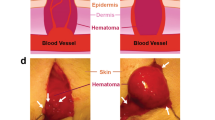Summary
The present paper reports the central role of fibrin (and specifically its pre-stage, fibrinogen), thrombin and coagulation factor XIII in wound healing and scar formation. The significance of these three factors has led to the development of a tissue adhesion system on a physiological basis, which can be applied in widely varying areas of surgery.
The adhesive allows the exact, flat adaptation of the wound edges and thus promotes flawless scar formation. Two case reports complete the exposition.
Similar content being viewed by others
References
Beck, E., Duckert, F., Ernst, M.: The influence of fibrin stabilizing factor on the growth of fibroblasts in vitro and wound healing. Thrombos. Diathes. haemorrh. (Stuttg.),6, 485 (1961)
Braun, F., Holle, J., Kovac, W., Lindner, A., Spängler, H. P.: Untersuchungen über die Replantation autologer Vollhaut mit Hilfe von hochkonzentriertem Fibrinogen und Blutgerinnungsfaktor XIII. Wien. Med. Wochenschr.125, 213 (1975)
Cassau, D., Siewert, R., Osten, W.: Fibrinstabilisierung bei der vollständigen Wunddehiszenz. Chirurg40, 76 (1969)
Dürr, W., Heller, W., Koslowski, L., Matis, P.: Beitrag zum Nachweis und zur klinischen Bedeutung des Faktor XIII. Med. Welt14, 761 (1969)
Haas, E.: Nahttechniken, Narben und Narbenkorrekturen. In: Plastische Chirurgie im Gesichts-Hals-Bereich Seite 47. Stuttgart: Georg Thieme 1976.
Laki, K., Lorand, J.: On the solubility of fibrin clots. Science108, 280 (1948)
Matras, H., Dinges, H. P., Lassmann, H., Mamoli, B.: Zur nahtlosen interfaszikulären Nerventransplantation im Tierexperiment. Wien. Med. Wochenschr.122, 517 (1972)
Matras, H., Braun, F., Lassmann, H., Ammerer, H. P., Mamoli, B.: Plasma clot welding of nerves (Experimental Report). J. Maxillofac. Surg.4, 236 (1973)
Spängler, H. P.: Gewebeklebung und lokale Blutstillung mit Fibrinogen, Thrombin und Blutgerinnungsfaktor XIII (Experimentelle Untersuchungen und klinische Erfahrungen). Wien. Klin. Wochenschr.88 [Suppl.]49, 3 (1976)
Staindl, O.: Die Gewebeklebung mit hochkonzentriertem, humanen Fibrinogen am Beispiel der freien, autologen Hauttransplantation. Arch. Otorhinolaryngol.217, 219 (1977)
Staindl, O.: Die Saundersplastik bei Morbus Osler unter Verwendung hochkonzentrierten humanen Fibrinogens als Gewebekleber. Laryngol. Rhinol. Otol. (Stuttg.)56, 887 (1977)
Staindl, O.: Frontobasale Verletzungen. Richtlinien der operativen Versorgung unter Berücksichtigung hochkonzentrierten humanen Fibrinogens als Gewebekleber. Wien. Med. Wochenschr.128, 387 (1978)
Staindl, O.: Tissue adhesion with highly concentrated human fibrinogen in O.R.L. Ann. Otol. Rhinol. Laryngol. (in press) (1979)
Tidrick, R. T., Warner, E. D.: Fibrin fixation of skin transplants. Surgery15, 90 (1944)
Author information
Authors and Affiliations
Rights and permissions
About this article
Cite this article
Staindl, O. The healing of wounds and scar formation under the influence of a tissue adhesion system with fibrinogen, thrombin, and coagulation factor XIII. Arch Otorhinolaryngol 222, 241–245 (1979). https://doi.org/10.1007/BF01261169
Received:
Issue Date:
DOI: https://doi.org/10.1007/BF01261169




